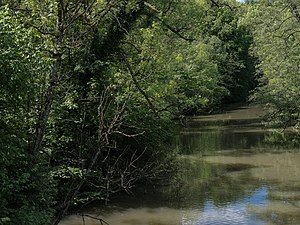Lower Remstal and Backnanger Bay
|
FFH area "Lower Remstal and Backnanger Bay"
|
||
|
Rems south of Remseck am Neckar |
||
| location | Rems-Murr district and Ludwigsburg district , Baden-Württemberg , Germany | |
| Identifier | DE-7121-341 | |
| WDPA ID | 555521806 | |
| Natura 2000 ID | DE7121341 | |
| FFH area | 7,957 km² | |
| Geographical location | 48 ° 52 ' N , 9 ° 19' E | |
|
|
||
| Setup date | January 1, 2005 | |
| administration | Regional Council Stuttgart | |
The FFH area Lower Remstal and Backnanger Bay is a protected area (protected area identifier DE-7121-341) in the German state of Baden- which was registered in 2005 by the Stuttgart Regional Council according to Directive 92/43 / EEC (Fauna-Flora-Habitat Directive) Württemberg . With the ordinance of the regional council of Stuttgart on the definition of areas of community importance of October 30, 2018, the protected area was established.
location
The widely scattered, 795.7 hectare protected area belongs to the natural areas 107 - Schurwald and Welzheimer Wald , 108 - Swabian-Franconian Forest Mountains and 123 - Neckar Basin . It lies between Remseck am Neckar and Auenwald and extends over the markings of ten cities and communities.
District of Ludwigsburg:
- Affalterbach : 96.3345 ha = 12%
- Remseck am Neckar : 104.3624 ha = 13%
Rems-Murr district:
- Althütte : 8.0278 ha = 1%
- Alluvial forest : 160.5575 ha = 20%
- Backnang : 8.0278 ha = 1%
- Burgstetten : 24.0836 ha = 3%
- Fellbach : 16.0557 ha = 2%
- Schwaikheim : 8.0278 ha = 1%
- Waiblingen : 256.8921 ha = 32%
- Weissach im Tal : 120.4181 ha = 15%
Description and purpose of protection
Meandering Rems with natural flow dynamics, hillside forests on the steep banks of the Neckar and Rems, near-natural meandering lower reaches of the Buchenbach, orchard slopes and deciduous forests along the edge of the Keup step.
Habitat classes
(general characteristics of the area) (percentage of total area)
Information according to the standard data sheet from the Official Journal of the European Union
| N09 - dry grassland, steppes | 8th % | |||
| N10 - Moist and mesophilic grassland | 30% | |||
| N15 - Other farmland | 8th % | |||
| N16 - deciduous forest | 25% | |||
| N17 - coniferous forest | 2% | |||
| N19 - mixed forest | 25% | |||
| N22 - inland rocks, scree and rubble heaps, sandy areas | 1 % | |||
| N23 - Other (cities, roads, landfills, pits, industrial areas) | 1 % | |||
Habitat types
The following habitat types according to Annex I of the Habitats Directive occur in the area:
| EU code |
Habitat type (official name) | Short name | Area in hectares |
|---|---|---|---|
| 3150 | Natural eutrophic lakes with magnopotamion or hydrocharition vegetation | Natural nutrient-rich lakes | 1.00 |
| 6110 | Gap basophilic or lime pioneer lawn (Alysso-Sedion albi) | Base-rich or lime pioneer lawn | 0.007 |
| 6430 | Moist tall herbaceous vegetation of the planar and montane to alpine level | Moist tall herbaceous vegetation | 2.12 |
| 6510 | Lean lowland hay meadows (Alopecurus pratensis, Sanguisorba officinalis) | Lean, lowland hay meadows | 75.00 |
| 7220 | Tufa springs (cratoneurion) | Tufa springs | 1.30 |
| 8210 | Limestone cliffs with crevice vegetation | Limestone cliffs with crevice vegetation | 0.20 |
| 8310 | Caves that are not open to tourists | Caves and balms | 0.001 |
| 9110 | Grove beech forest (Luzulo-Fagetum) | Grove beech forest | 18.10 |
| 9160 | Subatlantic or Central European Pedunculate Oak Forest or Oak-Hornbeam Forest (Carpinion betuli) | Chickweed-oak-hornbeam forest | 6.40 |
| 9180 | Mixed ravine and hillside forests (Tilio-Acerion) | Mixed ravine and hillside forests | 1.80 |
| 91E0 | Alluvial forests with Alnus glutinosa and Fraxinus excelsior (Alno-Padion, Alnion incanae, Salicion albae) | Alluvial forests with alder, ash, willow | 16.60 |
Contiguous protected areas
Several landscape protection areas completely or partially overlap with the FFH area. The area is 45% of its area in the bird sanctuary Unteres Remstal and 35% of the area is in the Swabian-Franconian Forest Nature Park . The following nature reserves are in the FFH area:

